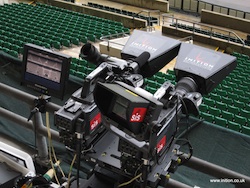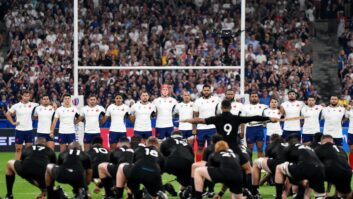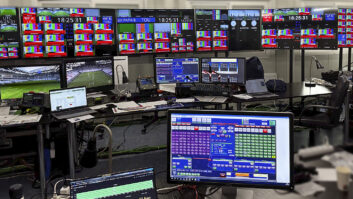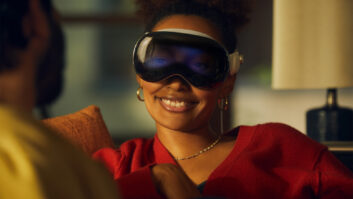
Three international matches in the recent Six Nations rugby competition were covered in 3D, with 3D specialists Inition overseeing the first two matches from Twickenham. The resulting 3D broadcast was transmitted to 40 cinemas around England, as David Fox reports.
The matches were shot at 25fps for each camera (combining for 50fps, which was upconverted for display to 60fps, as that is what the projectors could handle in the cinema). Each match was covered with eight camera positions, using a mixture of Sony 950 and 1500 cameras (including split head versions, which fit better on beam splitter/mirror rigs as they are more compact and weigh less).
All the rigs were from Element Technica, including the Quasar beam splitter rig. For the first match there were three beam splitter and three side-by-side rigs (two and four respectively for the second match), plus a 3D Steadicam (a side-by-side rig developed by Presteigne Hire, using miniature cameras – “very much a prototype camera, but it seems to work very well,” says stereographer, Campbell Goodwille). There was also a single pitch level camera on the halfway line, linked to a JVC 2D to 3D converter.
There were also 3D Transvideo monitors at each 3D camera position, so that the operators could check alignment, etc., locally. Using beam splitter rigs live required extra cards in the vision mixer to be able to flip a channel.
SIS provided the OB, using a standard HD outside broadcast truck. Inition added a JVC 3D plasma display, and its own StereoBrain 3D processors, which it developed with Numedia Technology. The broadcast was mixed in a standard vision mixer using dual channels. The vision mixer had to be reprogrammed, to deal with issues of timing and flipping mirror images. “It’s essential to monitor sync and timing between left eye and right eye,” explains Inition director, Andy Millns (who will be one of the speakers at 3D Masters 2010, to be held at BAFTA in London on June 22).
They also had to integrate the OB’s EVS systems and add graphics, the 3D encoder and the framerate conversion for cinema. Millns was seated next to the director in the OB truck (Inition used the same director that had done the first 3D rugby experiment for the BBC in 2008). “Certain camera angles are better in 3D, but you also have to tell the story of the game.” To make the most of 3D, they used the pitch-side cameras more and cut more slowly.
“We probably punched the 3D a little bit more in the wide positions for the second match. It’s very difficult to get much 3D from those positions. Shooting anything from long range in 3D is difficult,” says Goodwille. This meant putting the cameras further apart, which is why one position was moved from a mirror rig to side-by-side for the second game.
Practice match
Inition did a lot of pre-visualisation work before getting to the stadium, “to work out what rigs we’d need in each position and what focal lengths we’d be looking at,” he says. They spent three days before the first event setting up the OB truck, including matching all the lenses. There were also grip issues, such as where to put the monitor and lens controller. “A lot of it is film gear that we have to integrate with broadcast,” says Millns.
“The most important thing is to get the correct [camera] positions, otherwise you won’t get the drama people expect, especially pitch level. We were lucky we got three pitch level positions,” he adds. You have to also work with the director to show what works for 3D, but “you have to tell the story of the game primarily and the 3D is an added bonus.”
“We were a lot more ambitious on the second game, with some improved added graphics, where the stereoscopic functionality of the software was improved to enable them to render out better quality 3D,” says Goodwille.
The Ireland match also used one of Sony’s new 3D image processing boxes on one camera, “so we could use that position as a variable one, as we could re-set the focal lengths fairly quickly, otherwise we couldn’t’ really zoom,” explains Goodwille. “If you pick two broadcast lenses off the shelf, they don’t really track very well together as you zoom, and you go out of alignment.” However, the time spent beforehand working out which pairs of lenses worked best together meant they could do a limited amount of zooming between cuts.
Goodwille says that better lens control systems for 3D are coming, with Fujinon, for example, working on them at the moment. “That will make a big difference in using standard broadcast lenses for 3D.”
The operators would pull convergence during a shot, as play came towards the camera, “otherwise the player would come out of the screen towards you.” Convergence on all the rigs was motorised, and controlled by the 3D camera assistant using a remote from Element Technica, which comes with the rigs as an integrated system.
The Steadicam was locked off, but in future it might be possible to have some remote control over the 3D functions. “At the moment, we give the operator a range over which it will work well.”
The parts of the game that worked best in 3D were the lineouts, rucks and mauls close to the touchline. “Any time the action gets close,” says Goodwille.
It helps that rugby has a lot of action close to the touchline, which produced “some good 3D moments.” It is certainly better than soccer in that respect. Inition did a football game for France Telecom in 3D in Lyon last year which was “very successful and resulted in some very nice footage, but one of the difficulties is getting the right positions in the stadium,” says Goodwille. “Not only are there 2D cameras already in position, but you can’t put the relatively bulky 3D rigs in certain positions because of seat kill.”
At Twickenham, Inition were on the opposite side of the pitch to the BBC, but were still relatively limited. “We would like to have had another Steadicam at pitch level and another 3D camera on the halfway line.”
State of play
Tennis works very well in 3D. “Games that are in a relatively confined space, so you can get a bit closer, work very well.” Snooker, for example, could benefit from 3D, in the same way it did from the introduction of colour, and Inition has also shot boxing in 3D.
Goodwille has also worked on cricket and golf tests for Sky, and got very nice results. “It’s all about positions. Golf is difficult to cover, even in 2D. Trying to do it in 3D, the amount of camera positions they’d need would be tricky, but it can certainly be great and add to the coverage.” For cricket, 3D would require a lot of innovation, requiring much smaller cameras for a stump cam, and getting the umpires to wear cameras. “You need to get in amongst the action.”
He believes that extreme sports look particularly good in 3D. “Ice hockey is tricky, because it is so fast moving, but it can work pretty well.” Inition has also shot wildlife material in 3D in Kenya. “It’s probably some of the best footage we’ve shot. And there are plenty of other areas that could benefit hugely from the 3D treatment.”
Inition is working with other companies on basic technology, such as subtitling and encoding. The rugby transmission to cinemas used the Sensio format, which squashes the two images side-by-side into a single frame. It also does some clever sub-sampling to improve image quality. The broadcast was managed by Arqiva, which handled the decoding in cinemas into a single standard digital projector using the RealD system.
“Ideally, projectors in the cinema would run at 150Hz, but most were only 120Hz, max, so we had to convert from 50 to 60 and do a double flash,” explains Goodwille. “It was only being broadcast at 720p, and we’d like to see it at 1080, especially for the wide shots.”
All the equipment in the cinemas was installed for the event. “It had never been done before in this country,” adds Millns.
After the first match, pre-registration for the second was very high, “so rugby fans were obviously happy with it.” Because they were sports fans rather than geeks, “we had to give them the game first and foremost, and make sure they didn’t get headaches. The 3D result was our third priority.”
Both games were sold out in advance, and Millns is “extremely keen” to do more, as the cinemas are now equipped to take them. However, the ticket sales from 40 cinemas are not enough to support it (“maybe 400 cinemas”), so it does need to have sponsorship to be viable (mobile phone company, O2 sponsored the rugby). Further sports and music events are in discussion.
Live 2D to 3D conversion
Inition used JVC’s IF-2D3D1 real-time 2D to 3D conversion system, which can output in a variety of 3D formats, and includes Parallax and 3D Intensity adjustments. “It is a useful tool for positions where you either can’t get a 3D rig to or where you won’t be able to get much 3D – mainly on long lens, zoomed-in, footage. But you have to be selective in your use of it, because alongside true stereoscopic 3D footage, you can see the difference. It definitely serves a purpose, but it has to be used sparingly,” says Campbell Goodwille. “It’s not a substitute, but it is a useful addition.”
“It just allows us the freedom to do very long lens shots,” says Andy Millns. “That sort of shot probably wouldn’t be very successful in [true] 3D anyway.” However, using the converter means “it intercuts better. It gives it a 3D feel. It’s less jarring that using a pure 2D shot.”
It is particularly effective if you get the framing right. “The contour (the way it sculpts the image) presumes that things at the bottom of the picture are close to you. If shots don’t conform to that it’s not as successful,” says Millns.
Inition used it for the rugby because it wasn’t possible to get a 3D rig in that position. “It will serve certain purposes, particularly live,” he believes. For recorded productions it is also possible to convert 2D to 3D in post, and achieve better results, but this isn’t possible for a live event.






